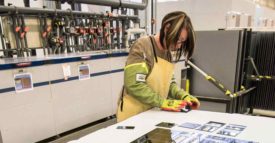Automated Assembly Systems
Robots Assemble Pressure Sensors
High-speed system produces 4 million pressure sensors annually.
January 16, 2023
Automation Shines at First Solar
A highly automated manufacturing process helps first solar compete with cheap imports.
January 8, 2023
Robots Assemble Electric Vehicles
Automakers need to be flexible and adopt new automation.
December 21, 2022
Capital Spending Survey 2022: Assemblers Continue to Invest
Buoyed by efforts to boost domestic production of EVs and electronics, manufacturers are investing in their assembly operations.
December 1, 2022
Screwdriving Gripper Mimics Two-Handed Assembly
Researchers have developed a single end-of-arm tool that can simultaneously hold a part in place and install it at the same time.
November 29, 2022
Never miss the latest news and trends driving the manufacturing industry
Stay in the know on the latest assembly trends.
JOIN TODAY!Copyright ©2024. All Rights Reserved BNP Media.
Design, CMS, Hosting & Web Development :: ePublishing












